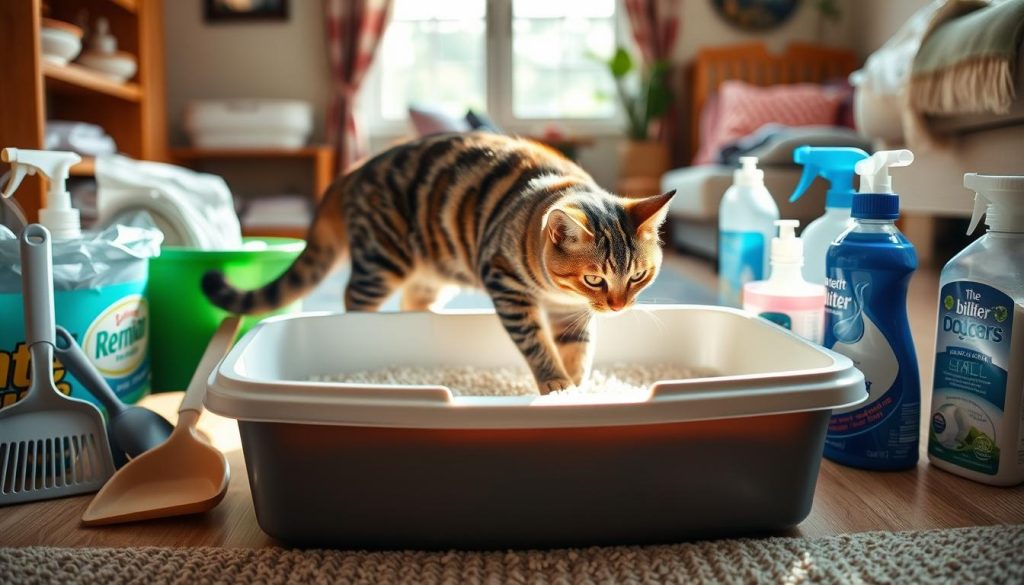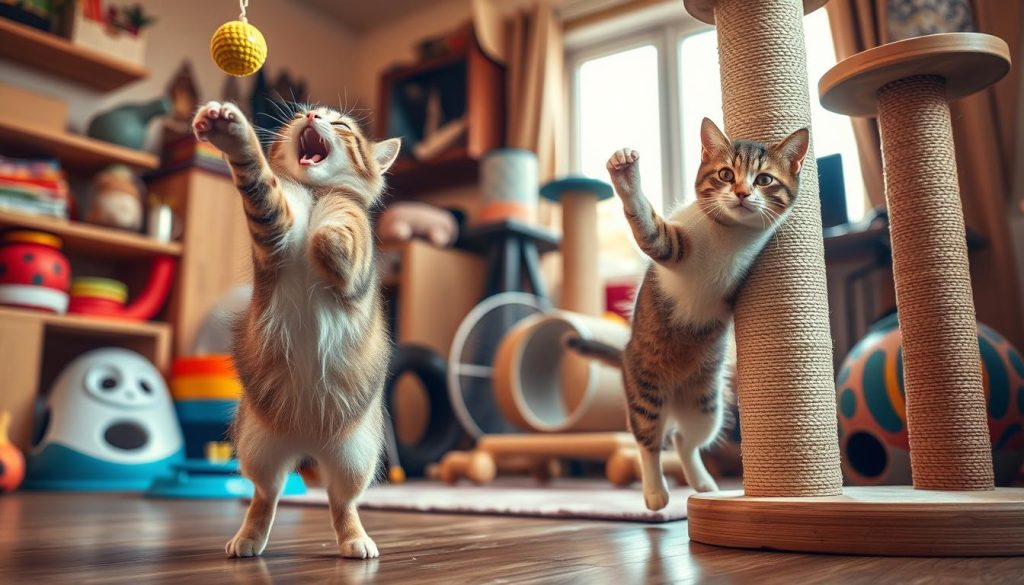Preventive care plays a crucial role in ensuring your cat enjoys a long, happy life. With proper attention, your feline friend can thrive for over 14 years. This guide outlines the top 7 ways to maintain your cat’s health and happiness, focusing on essential aspects like nutrition, hydration, and a comfortable living environment.
A well-balanced diet, constant access to fresh water, and a clean litter box are fundamental. Using the right food bowls and water fountains can significantly improve your cat’s eating habits. Regular vet checkups, effective grooming, and stimulating exercise are also vital for their well-being.
Recent studies emphasize the importance of proactive care in maintaining your cat’s health. By addressing these key areas, you can help your cat live a fulfilling and joyful life.
Key Takeaways
- Provide a balanced diet and fresh water.
- Maintain a clean and accessible litter box.
- Schedule regular veterinary checkups.
- Encourage exercise with cat toys.
- Practice regular grooming for health.
Introduction to Feline Health and Happiness
Feline health and happiness are deeply connected, as a cat’s well-being directly influences its quality of life. Ensuring your cat leads a joyful and healthy life involves understanding its natural behaviors and providing the right environment.
Cats are known for their independence, but they still require attentive care. A balanced diet and fresh water are essential for maintaining their health. Feeding your cat at scheduled times helps manage their weight and prevents overeating.
| Aspect of Care | Importance | Best Practices |
|---|---|---|
| Diet | Ensures proper nutrition | High-quality cat food |
| Water | Hydration is crucial | Always available |
| Litterbox | Maintains cleanliness | Cleaned daily |
| Vet Visits | Early detection of issues | Regular checkups |
Regular grooming and playtime with cat toys can help detect potential health problems early. A clean litterbox and a stimulating environment contribute to your cat’s overall well-being. By following these care tips, you can help your cat live a happy and healthy life.
Understanding Your Cat’s Nutritional Needs
Proper nutrition is the cornerstone of a long and thriving life for your feline companion. A well-balanced diet ensures your cat gets all the necessary nutrients to stay active and healthy.
Many veterinarians recommend wet food because it has lower carbohydrate content. This helps reduce the risk of obesity and diabetes. Wet food also mimics a cat’s natural diet more closely, making it easier for them to digest.
Portion control is crucial. Overfeeding can lead to weight issues, which can cause long-term health problems. Scheduled meal times help maintain your cat’s weight and prevent overeating.
Nutritional imbalances can lead to serious health issues. For example, a lack of certain vitamins can weaken your cat’s immune system. A balanced diet goes hand-in-hand with overall preventive care.
Consulting with a veterinarian can help tailor a diet plan that meets your cat’s specific needs. They can provide expert advice based on your cat’s age, lifestyle, and any health conditions.
A healthy diet plan should be based on veterinary research. For example, kittens need more protein than adult cats, while senior cats may require fewer calories. Understanding these differences can help you make informed decisions about your cat’s meals.
By focusing on proper nutrition, you can help your cat live a happy and healthy life. Always consult with your vet to ensure you’re providing the best possible diet for your feline friend.
How To Keep Your Cat Healthy
Maintaining your cat’s health requires attention to several key areas. A well-balanced diet, regular exercise, and a clean environment are essential for your feline friend’s well-being.
Feeding your cat at set times helps manage their weight and prevents overeating. Wet food is often recommended because it mimics a cat’s natural diet and has lower carbohydrates, reducing the risk of obesity and diabetes.
Portion control is crucial. Overfeeding can lead to weight issues, which can cause long-term health problems. Scheduled meal times help maintain your cat’s weight and prevent overeating.
Nutritional imbalances can lead to serious health issues. For example, a lack of certain vitamins can weaken your cat’s immune system. A balanced diet goes hand-in-hand with overall preventive care.
Consulting with a veterinarian can help tailor a diet plan that meets your cat’s specific needs. They can provide expert advice based on your cat’s age, lifestyle, and any health conditions.
| Aspect of Care | Importance | Best Practices |
|---|---|---|
| Diet | Ensures proper nutrition | High-quality cat food |
| Water | Hydration is crucial | Always available |
| Litterbox | Maintains cleanliness | Cleaned daily |
| Vet Visits | Early detection of issues | Regular checkups |
Regular grooming and playtime with cat toys can help detect potential health problems early. A clean litterbox and a stimulating environment contribute to your cat’s overall well-being. By following these care tips, you can help your cat live a happy and healthy life.
Providing Proper Hydration and Food Bowls
Water is essential for your cat’s survival, making up 60% of their body weight. Proper hydration helps prevent urinary tract infections and kidney disease, common issues in cats.
Flat, wide food bowls reduce whisker fatigue, making mealtime more comfortable. Similarly, cat water fountains encourage drinking by mimicking natural water flow.
Using the right feeding gear can prevent overeating, which can lead to weight gain and related health risks. Stainless steel or ceramic bowls are best as they are easy to clean and durable.
A well-designed feeding area can significantly enhance your cat’s dining experience. By paying attention to these details, you can help reduce health risks and ensure your cat stays happy and thriving.
| Feeding Accessory | Benefit | Best Practice |
|---|---|---|
| Flat, Wide Bowls | Reduces whisker fatigue | Use ceramic or stainless steel |
| Cat Water Fountains | Encourages more drinking | Clean regularly to prevent bacteria |
| High-Quality Bowls | Prevents overeating | Choose durable, easy-to-clean materials |
Creating a Cat-Friendly Home Environment
Designing a living space that caters to your feline friend’s natural instincts can significantly enhance their comfort and happiness. Cats thrive in environments that provide privacy, stimulation, and easy access to essential resources.
Optimal Litterbox Placement and Setup
When setting up your cat’s litterbox, consider both privacy and accessibility. Place the litterbox in a quiet, low-traffic area where your cat feels safe. The ideal size for a litterbox is 1.5 times the length of your cat, ensuring comfort and ease of use. Avoid placing the litterbox near your cat’s food or water to prevent confusion and stress.
Choosing Safe Cat Toys and Perches
Selecting the right toys and perches is crucial for your cat’s safety and engagement. Opt for toys made from non-toxic materials, such as feather wands or interactive laser toys, which encourage natural hunting behaviors. Avoid toys with small parts that can be easily detached and swallowed. For perches, choose sturdy, well-secured cat trees that allow your cat to climb, observe, and relax in a safe environment.
By creating a cat-friendly home, you can help reduce stress and prevent potential health issues, ensuring your cat leads a happy and fulfilling life.
Essential Grooming and Hygiene Practices
Grooming is more than just a beauty routine for cats—it’s a vital part of their health and well-being. Regular grooming helps prevent hairballs, reduces shedding, and strengthens the bond between you and your pet.
Brushing, Hairball Prevention, and Comb Use
A daily brushing session can make a big difference. Use a soft-bristled brush or a slicker comb to remove loose hair and tangles. This not only prevents hairballs but also reduces the risk of matted fur, which can be painful for your cat.
Nail Clipping and Oral Care
Nail clipping is another important part of grooming. Trim your cat’s nails every week to prevent overgrowth, which can cause discomfort and health issues. For oral care, brush your cat’s teeth regularly to prevent tartar buildup and bad breath. A healthy mouth contributes to overall well-being.
| Grooming Tool | Benefit | Best Practice |
|---|---|---|
| Soft-Bristled Brush | Reduces shedding | Use daily for 5-10 minutes |
| Slicker Comb | Prevents matting | Gentle strokes, especially for long-haired cats |
| Nail Clippers | Prevents overgrowth | Trim weekly, taking care not to cut the quick |
By incorporating these grooming practices into your routine, you can help your cat live a happier, healthier life. Remember, grooming is about more than looks—it’s a key part of their overall care.
Effective Litterbox Management for a Healthy Cat
Maintaining a clean litterbox is essential for your cat’s hygiene and overall well-being. A dirty litterbox can lead to health issues and unwanted behaviors. Regular cleaning helps prevent diseases and keeps your cat comfortable.

Daily Cleaning and Maintenance Tips
Scoop out solid waste and clumps daily to keep the litterbox clean. This simple routine helps reduce odors and prevents bacterial growth. Cats are sensitive to smell, and a clean box encourages proper use.
Weekly Deep Cleaning and Disinfecting
Once a week, change the litter completely. Disinfect the box with a pet-safe cleaner to remove any lingering bacteria. This helps prevent health issues and keeps your cat safe.
Choosing the Right Litter
Select a low-dust, odor-controlling litter to minimize mess and scent. Avoid scented litters if your cat is sensitive. The right litter makes maintenance easier and your cat happier.
Consistent litterbox care leads to a healthier, happier cat. It helps detect health issues early and prevents unwanted behaviors. Make it a priority for your cat’s well-being.
The Importance of Regular Veterinary Visits
Regular veterinary visits are a cornerstone of preventive care for cats. These checkups help identify potential health issues early, ensuring your cat leads a long and thriving life.
Preventative Care and Vaccination Schedules
Veterinarians recommend annual or biannual visits to maintain your cat’s health. These visits include essential vaccinations and wellness checks. For senior cats, more frequent visits may be necessary to monitor age-related health changes.
Monitoring Weight and Early Health Issues
Weight management is crucial for your cat’s health. Excess weight can lead to diabetes and joint problems. Your vet can help create a diet plan using high-quality food to maintain a healthy weight. Regular checkups also help detect early signs of disease, such as kidney issues, which are common in cats.
By staying on top of vet visits and weight management, you can help your cat avoid serious health problems. Early detection and preventive care ensure your feline friend enjoys a happy and healthy life with the family.
Incorporating Play and Exercise for Feline Fitness
Playtime is more than just fun for your cat—it’s essential for their physical and mental well-being. Regular exercise helps maintain a healthy weight, strengthens muscles, and keeps your cat active and engaged.
Interactive Toys and Cat Trees
Interactive toys like feather wands and laser pointers encourage natural hunting behaviors. These toys keep your cat moving and stimulated, making playtime both enjoyable and beneficial. Cat trees provide vertical space for climbing and perching, which helps develop strong muscles and coordination.

Encouraging Natural Scratching and Stretching
Natural scratching and stretching are vital for muscle development and claw health. Provide sturdy scratching posts to satisfy this instinct and promote flexibility. These activities also help reduce stress and maintain joint health.
Scheduled play sessions can prevent boredom and weight gain. Even short play periods can make a big difference in your cat’s overall fitness. By incorporating a variety of toys and activities, you can keep your cat entertained and active, ensuring a happy and healthy life.
Tips for Travel and Emergency Preparedness with Your Cat
Traveling with your cat or preparing for emergencies requires careful planning to ensure their safety and comfort. Whether it’s a road trip or an unexpected event, having the right strategies in place can make all the difference.
Selecting the right carrier is essential. A top-loading carrier is often recommended as it allows for easier placement and can reduce stress during travel. When preparing an emergency kit, include essentials like food, water, medication, and a first-aid kit tailored for your cat.
Reducing travel stress is crucial for your cat’s well-being. Introduce the carrier gradually, making it a comfortable space with familiar bedding. This helps your cat become accustomed to it before any trip or emergency situation arises.Additional safety measures include securing the carrier during travel and ensuring your cat wears an ID tag. For vet visits, plan routes in advance and keep your cat calm with familiar toys or blankets.
- Choose a sturdy, well-ventilated carrier for safe travel.
- Include a familiar toy and treats in the emergency kit to comfort your cat.
- Plan regular breaks during long trips for your cat to stretch and relax.
- Keep your vet’s contact information easily accessible in case of emergencies.
By planning ahead and staying prepared, you can help ensure your cat’s safety and comfort during travel or emergencies. Always prioritize their well-being with the right gear and a thoughtful approach.
Conclusion
Ensuring your cat’s well-being involves a combination of proper nutrition, a clean environment, regular grooming, and consistent veterinary care. By focusing on these key areas, you can create a balanced and healthy lifestyle for your feline companion.
Nutrition plays a vital role in your cat’s health, with high-quality food and fresh water being essential. A clean litterbox and a stimulating environment also contribute to their happiness and reduce the risk of health issues. Regular grooming and playtime are equally important, helping to detect potential problems early and keeping your cat active and engaged.
By implementing these care tips, you can help your cat enjoy a longer, happier life. Remember, every small effort you make contributes to their overall well-being. If you have specific concerns or need personalized advice, consulting a veterinarian is always a good idea.
With dedication and the right approach, your cat can become a joyful and loving companion for years to come. Take the time to review these tips and create a care routine that suits your cat’s needs. Your efforts will surely be rewarded with a happy, healthy, and thriving feline friend.





